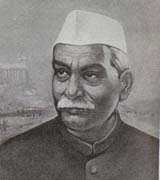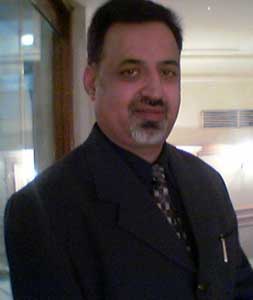 |
 |
|
|
 |
| Dr. Rajendra Prasad, son
of Mahadev Sahai, was born in Zeradei village in Bihar on December 3, 1884.
Being the youngest in a large joint family "Rajen" was greatly loved and
was strongly attached to his mother and elder brother Mahendra. Zeradei's
population was cosmopolitan in nature and the people lived together in
happiness and harmony. Rajendra Prasad's earliest memories are playing
"kabaddi" with his Hindu and Muslim friends. Rajen was married when he
was barely 12 years old to Rajvanshi Devi.
Rajen was a brilliant student throughout school and college. He stood first in the entrance examination of the University of Calcutta and was awarded a Rs. 30 per month scholarship. It was first time that a student from Bihar had excelled. He joined the Calcutta Presidency College in 1902. The partition of Bengal in 1905 fueled the swadeshi and boycott movements. The movements had a deep effect on students in Calcutta. One day, residents of his hostel created a bonfire of all the foreign clothings they had. When Rajen went through his belongings he could not find a single item of foreign clothing. Gopal Krishna Gokhale had started the Servants of India Society in 1905 and asked Rajen to join. So strong was his sense of duty toward his family and education that he, after much deliberation, refused Gokhale, one of the greatest nationalists of the time. Rajen recalled, "I was miserable" and for the first time in his life he barely got through his B.L. examinations. In 1915, Rajen passed the Masters in Law examination with honors, winning a gold medal. He then completed his Doctorate in Law to attain the title, Dr. Rajendra Prasad. |
||||||
|
A court notice was served to Gandhiji. He declared that he had disobeyed the order to leave Champaran in obedience to the highest law he knew, "the voice of conscience." The case against Gandhiji was dropped. He, along with his volunteers was allowed to complete their inquiry and the Governments of Bihar and Orissa passed an Act to alleviate the burden on the peasant based on the report compiled by Gandhiji and his volunteers. From that point onward, Dr. Prasad became Gandhiji's dedicated follower. Gandhiji's influence greatly altered many of Dr. Prasad's views, most importantly, on untouchability. Gandhiji made Dr. Prasad realize that when the nation was working for a common cause, they "became of one caste, namely the caste of co-workers." Dr. Prasad immediately simplified his already simple life. He reduced the number of servants he had to one. He no longer felt shame in sweeping the floor, or washing his own utensils. Whenever the people suffered, Dr. Prasad was present to help reduce the pain. In 1914 floods ravaged Bihar and Bengal. Dr. Prasad became a volunteer distributing food and cloth to the flood victims. In 1934, Bihar was shaken by an earthquake. The quake caused immense damage and loss of property. The quake was followed by floods and an outbreak of malaria. Dr. Prasad dove right in with relief work, collecting food, clothes and medicine. In 1935, an earthquake hit Quetta. Dr. Prasad was not allowed to lend a hand because of Government restrictions. He did not rest. He set up relief committees in Sind and Punjab for the homeless victims that flocked there. Dr. Prasad was shocked by
the Government atrocities at Jallianwalla Bagh. He called for non-cooperation
in Bihar as part of Gandhiji's non-cooperation movement. Dr. Prasad gave
up his law practice and started a National College near Patna, 1921. The
college was later shifted to Sadaqat Ashram on the banks of the Ganga.
The non-cooperation movement in Bihar spread like wildfire. Dr. Prasad
toured the state, holding public meeting after another, collecting funds
and galvanizing the nation for a complete boycott of all schools, colleges
and Government offices. He urged the people to take to spinning and wear
only khadi. Bihar and the entire nation was taken by storm, the people
responded to the leaders' call. The machinery of the mighty British Raj
was coming to a grinding... halt.
In 1934, Dr. Prasad's elder brother, Mahendra died. Rajen was deeply affected and he turned to the Gita to seek solace. Dr. Prasad presided over the Bombay session of the Indian National Congress in October 1934. Following the resignation of Subhash Chandra Bose as the President of the Congress in April 1939, Dr. Prasad was elected President. He did his best to heal the rifts created between the incompatible ideology of Subhash Chandra Bose and Gandhiji. Rabindranath Tagore wrote to Dr. Prasad, "I feel assured in my mind that your personality will help to soothe the injured souls and bring peace and unity into an atmosphere of mistrust and chaos..." As the freedom struggle progressed, the dark shadow of communalism which had always lurked in the background, steadily grew. To Dr. Prasad's dismay communal riots began spontaneously burst all over the nation and in Bihar. He rushed from one scene to another to control the riots. Independence was fast approaching and so was the prospect of partition. Dr. Prasad, who had such fond memories of playing with his Hindu and Muslim friends in Zeradei, now had the misfortune of witnessing the nation being ripped into two. On August 15, 1947 India was free. Earlier, a Constituent Assembly was formed in July 1946, to frame the Constitution of India and Dr. Rajendra Prasad was elected its President. On November 26, 1946 the Constitution of India was completed and accepted by the people of India. On January 26, 1950, the Constitution was ratified and Dr. Rajendra Prasad was elected the first President of India. Dr. Prasad transformed the regal splendor of Rashtrapati Bhavan into an elegant "Indian" home. Dr. Prasad visited many countries on missions of goodwill. He stressed for peace in a nuclear age. In 1962, after 12 years as President, Dr. Prasad retired. He was awarded the highest civilian award of India, the Bharat Ratna. Dr. Prasad authored many books including his autobiography "Atmakatha" (1946), "Satyagraha at Champaran" (1922), "India Divided" (1946), "Mahatma Gandhi and Bihar, Some Reminisences" (1949), and "Bapu ke Kadmon Mein" (1954). Dr. Prasad spent the last few months of his life at the Sadaqat Ashram in Patna. He died on February 28, 1963.
|
||||||

Welcome to Rajesh Chopra's Guest Book and comments Please |
| Back to Home |
 |
 |
 |
 |